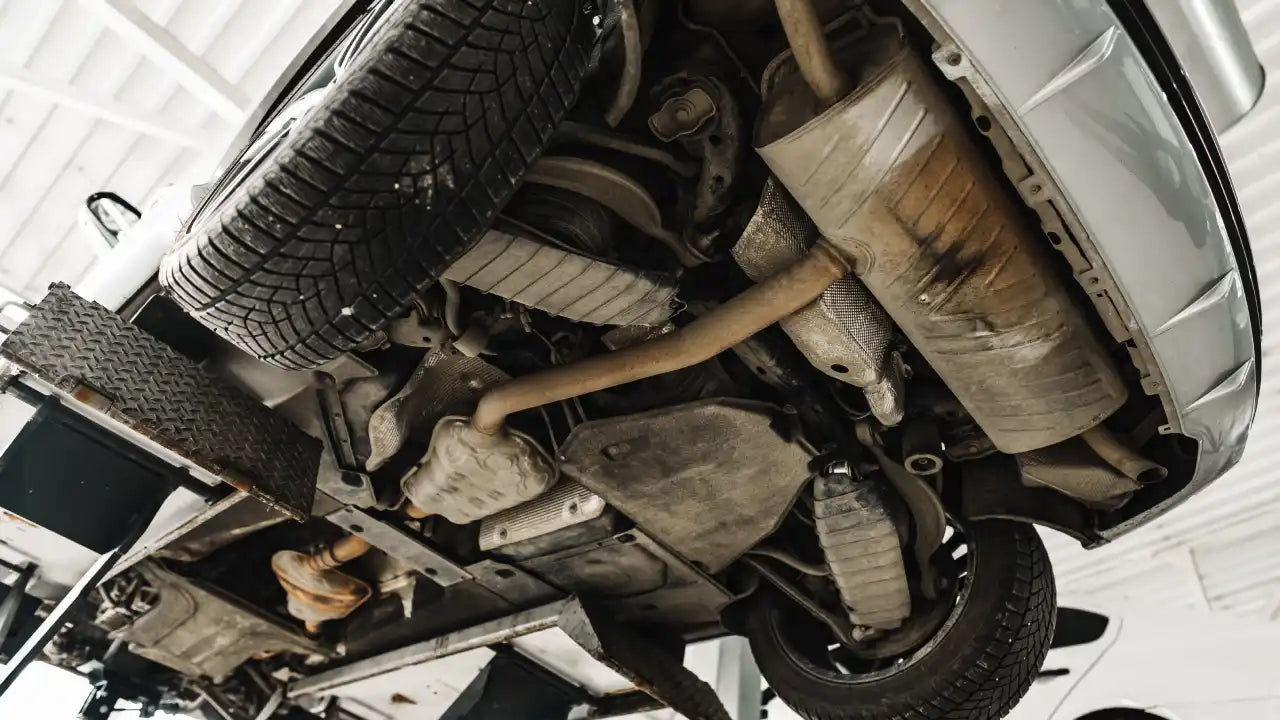A Simple Guide: Understanding the Basics of Exhaust System
Share
Exhaust refers to the system in a vehicle responsible for directing and expelling the gases produced during the combustion process out of the engine and away from the vehicle. It typically consists of many different components. In this article, we will explore everything about the exhaust system, from its components and functions to FAQs about the exhaust system, highlighting their significance in vehicle operation and environmental preservation.
What does an Exhaust System do?
The exhaust system in a vehicle removes combustion gases from the engine, reducing noise, controlling emissions, and improving overall engine performance. When fuel burns in the engine, it generates exhaust gases like carbon monoxide, hydrocarbons, and nitrogen oxides. So, the exhaust system collects these gases from the engine cylinders and channels them away from the engine’s occupants.

What are the Exhaust System Components?
The exhaust system is composed of several components. Let’s look at the functions of these exhaust components below:

Exhaust Manifold
Positioned directly at the engine’s cylinder head, the exhaust manifold serves as the initial collection point for exhaust gases generated during the combustion process in each cylinder. So, the exhaust manifold’s primary function is to gather and merge these gases before channeling them into the exhaust system. The design and efficiency of the manifold impact exhaust flow dynamics, which in turn influence the engine performance and emissions.
Catalytic Converter
The catalytic converter is a vital emission control device positioned downstream from the exhaust manifold. It contains a catalyst, typically comprising precious metals such as platinum, palladium, and rhodium, which facilitate chemical reactions to convert harmful pollutants in the exhaust gases into less harmful substances. So, the catalytic converter is crucial in reducing car emissions and ensuring compliance with environmental regulations.
Muffler
The muffler has a pivotal role in further reducing exhaust noise. It employs a combination of chambers, baffles, and acoustic insulation materials to absorb and dissipate sound waves generated by the engine. As exhaust gases pass through the muffler, sound energy is converted into heat energy, significantly reducing noise levels.
Exhaust Pipes
Exhaust pipes constructed from durable materials such as stainless steel or alıminum steel withstand high hydrocarbons, nitrogen oxides, temperatures, and corrosive exhaust gases. They are the conduit for exhaust gases to pass from the exhaust manifold to the tailpipe. The size and configuration of exhaust pipes affect engine performance.
Tailpipe
The tailpipe extends from the muffler to the vehicle's rear, expelling treated exhaust gases into the atmosphere. So, it ensures the safe and efficient release of exhaust emissions away from the vehicle and its occupants, contributing to a cleaner and quieter driving environment.
Why is the Exhaust System Important for Cars?
The exhaust system is crucial for cars due to several reasons:

- Emissions Control: It plays an important role in reducing harmful emissions by directing exhaust gases through components like catalytic converters, which convert pollutants into less harmful substances, ensuring compliance with environmental regulations and reducing air pollution.
- Noise Reduction: By incorporating components such as mufflers and resonators, the exhaust system helps minimize the noise generated by the engine during combustion, ensuring a quieter and more comfortable driving experience.
- Safety: The exhaust system directs toxic gases away from the engine and vehicle occupants, preventing the buildup of harmful fumes inside the car. Thus, it contributes to the safety and well-being of the driver and passengers.
- Engine Performance: An efficiently functioning exhaust system helps maintain optimal engine performance by ensuring proper exhaust gas flow, contributing to better fuel efficiency, power output, and overall engine health.
FAQs about Exhaust System
What are the signs of a failing exhaust system?
Failing exhaust system signs may include increased exhaust noise, visible smoke or emissions, reduced engine performance, foul odors, and illuminated warning lights on the dashboard. These symptoms could indicate issues with components like the muffler, catalytic converter, or exhaust pipes.
How often should I replace my vehicle’s exhaust system?
The lifespan of a vehicle’s exhaust system typically ranges from 5 to 7 years, but this can vary depending on some factors like driving conditions, maintenance, and the quality of the exhaust components.
Are there different types of exhaust systems available?
Yes, different types of exhaust systems are available, including stock exhaust systems, aftermarket exhaust systems for performance enhancements, and custom exhaust systems for specific vehicle modifications.













